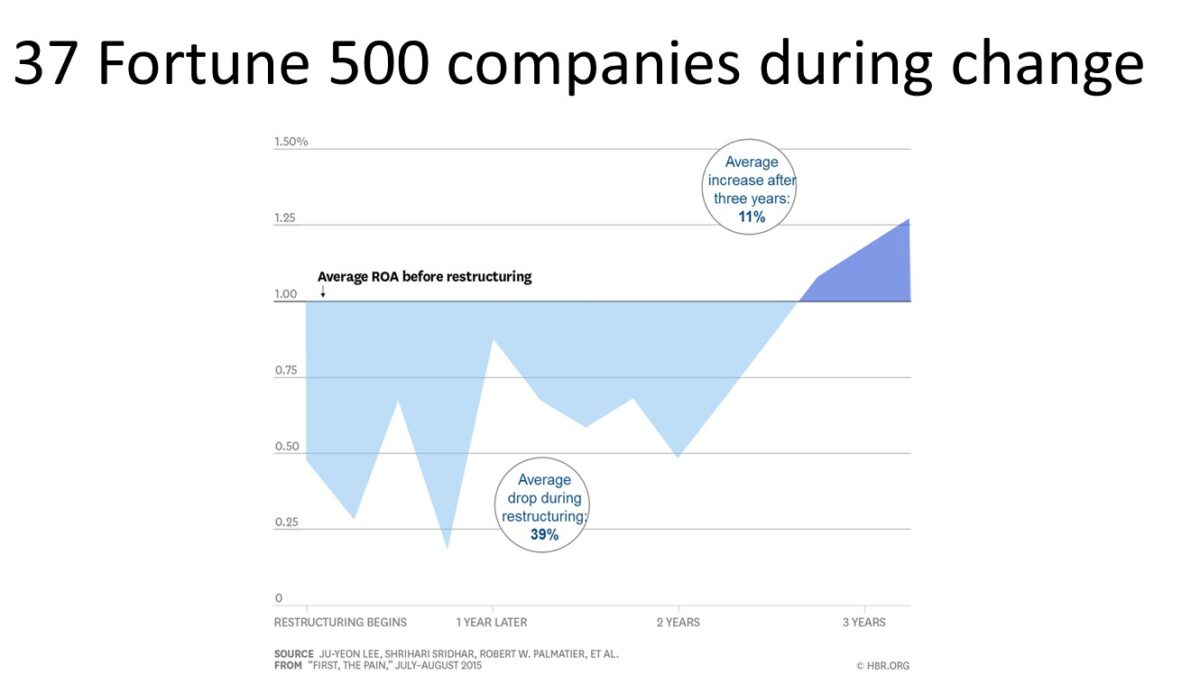
Four issues when presenting online and what to do
23/11/2023Probably, at the end of the year, or even for a longer time already, you may be thinking about ways to improve your customer focus and reorganize your company accordingly. Before you start, consider this:
A company’s strategy consists of two parts—
the organization and the people.
Which is easiest to change, and which do you think would be best to change? To add to these thoughts, here are two facts to consider.
Changing the organisation
Let’s take a look at changing the first part of the strategy—the organization. Here is a rare fact about change from an HBR publication in 2015 that is still on my mind. This short article reports on research about customer-centric restructuring in Fortune 500 companies. The researchers discovered that “among 37 Fortune 500 firms that went through customer-centric restructuring, the performance drop averaged 39% from companies’ pre-restructuring levels; it was only after 10 quarters that performance exceeded those levels—at which point it exceeded them by 11%, on average.”
Restructuring can cost companies 10 quarters
with an average of -39% in performance.
While such findings are remarkable, for anyone who has been through such a process, nobody is really surprised it takes such a long time: Teams get torn apart, and departments relocated; customer relationships get lost, people are confused making them hesitant and insecure; important goals lose focus, and essential actions get delayed. It takes time until the organization is back on its feet and running.
So why restructure? Restructuring is often considered to be the only option for a company to “get back on track.” This happens when top management, after many years of business as usual, of hoping for the better, of believing that competitors are not playing a fair game, of feeling comfortable in the market niche, and telling themselves that the goals were too hard to reach in the first place and they need to protect themselves first, realizes that they have “gotten off track” and they can go no further like this.
(https://www.n-tv.de/wirtschaft/Das-System-Volkswagen-droht-zu-zerbrechen-article24570230.html)
But where, or when, or better how did the whole business model derail?
Changing the people
Let’s take a look at the other part of a company’s strategy—the people—because here lies an alternative to restructuring the organization that only a few consider. Many top managers shy away from any consideration of changing the culture because they believe that culture eats strategy for breakfast.
In another case, while companies like the 37 Fortune 500 companies mentioned above were struggling at any phase of the two-year restructuring period with poor performance, another company could increase their overall performance by 47% without any restructuring, investments, or lay-offs. Over a two-year period, this specific company increased sales by 35%, profit increased by over 50%, and costs decreased by 17% without any organic market growth.
How could that be possible?
Leadership is about getting a group of people
to achieve common goals.
It was possible because this specific company focused on developing their managers to become leaders. The true role of a leader at any level of an organization is interacting with the people, helping them understand the goals of the organization, and creating priorities around the resources that are available to reach the goals. Leaders coach their people so that they perform within the given boundaries and priorities, and they follow up on the efforts their people have made so that they can have a feeling of accomplishment and progress.
I believe that when you don’t have good leadership at all levels of an organization, you won’t find many who really care about driving the teams to perform better. Too often then, you hear people in an organization saying, “We know what we should be doing, but we are not doing it.” But who is to blame when the knowing-doing gap is not closed?
Good leaders are with their teams
and address the no-doing gap every day.
This is what made the difference for the managers in this specific company that grew during the comparable two-year period. This company had good managers, and they understood the difference. Their newly found roles as leaders of their teams made this significant change possible; their overall performance increased by 47% without any restructuring, investments, or lay-offs.
If you want to know more about this success story and the two-year period this company went through, contact me in a private message, and I will share more details with you.
I wish you a relaxing and Merry Christmas, health and a prosperous New Year
Best regards
Coach Colin
